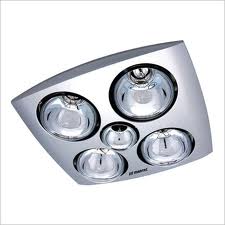I can’t say I was impressed. . . . It suffers from the Swiss Army Knife Syndrome…… doing lots of things, but none of them as well as a purpose designed tool.
It seems more sensible to me to have the fan directly above the shower and extract the steam at it’s source, rather than let it drift across the ceiling and then extract it.
As far as Lighting is concerned it’s easier to see yourself clearly in the mirror if the light is in the area between the mirror and you, rather than behind you. . .
I think that ladies putting on make-up in the bathroom will agree!
For heating I never seemed to get much heat from the heat lights. (One exception was a unit in a hotel bathroom with a low 2.1m ceiling)
The best bathroom heating solution for us has been a wall mounted fan heater
A couple of low price alternatives are:
- Leave the door partially open overnight allows enough heat from the ducted heating to flow through to the bathroom in the morning.
- Switch the bathroom fan on a few minutes before your shower and it will pull the warm air into the bathroom.
Thinking about underfloor heating? . . . Check out this Link : Underfloor Heating
For more see Bathroms and Ensuites
